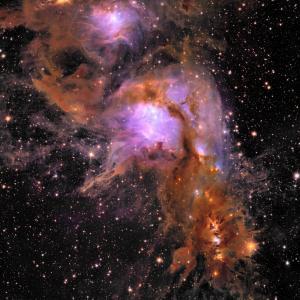Centro de Excelencia Severo Ochoa
Menu
Search

ESA’s Euclid mission has released five groundbreaking new images, showcasing the telescope's potential to unravel cosmic mysteries. These images are part of Euclid’s Early Release Observations, which accompany the mission’s first scientific data and 10 upcoming science papers. This wealth of information comes less than a year after the telescope's launch and about six months after its first full-color images.
The early observations targeted 17 astronomical objects, ranging from nearby gas and dust clouds to distant galaxy clusters, ahead of Euclid's main survey. This survey aims to uncover the secrets of dark matter and dark energy and explain the current state of the Universe.
Juan García-Bellido, a researcher at the IFT and director of the Gravity and Cosmology group that is part of Euclid, described this as a “new era” of cosmological observations: “We are entering a new era where ground-based telescopes like DESI or Vera Rubin compete with satellites like Euclid or JWST in unraveling the greatest mysteries of cosmology: the origin of dark matter and energy.”
“In a couple of years, we will have complete catalogs of the distribution of matter up to distances of 80% of the size of the universe, where the vast majority of galaxies reside,” he adds.

"Euclid is a unique, groundbreaking mission, and these are the first publicly available datasets – a significant milestone," states Valeria Pettorino, ESA’s Euclid Project Scientist. "The diversity of objects and distances observed in these images is impressive. Representing just 24 hours of observations, they provide a glimpse of Euclid's capabilities. We eagerly anticipate six more years of data."
"This telescope is designed to address the biggest open questions in cosmology," adds Valeria. "These initial observations demonstrate that Euclid is more than capable of achieving its goals."
Euclid will map the hidden structures of the cosmos, catalog billions of galaxies across over one-third of the sky, study cosmic history, and explore dark energy and dark matter.
The images obtained by Euclid are at least four times sharper than ground-based telescope images. They cover large sky areas at unprecedented depths, peering into the distant Universe with visible and infrared light.
"The results from Euclid are truly unprecedented," says ESA Director of Science, Prof. Carole Mundell. "Euclid's first images, published in November, highlighted its vast potential to explore the dark Universe. This second batch is equally impressive.
"Euclid's ability to cover large sky regions in detail and depth, capturing a variety of objects in one image – from faint to bright, distant to nearby, massive galaxy clusters to small planets – is remarkable. This versatility has led to numerous new scientific results that, combined with future survey data, will significantly enhance our understanding of the Universe."
While visually stunning, these images reveal new physical properties of the Universe thanks to Euclid's novel observing capabilities. These findings are detailed in accompanying papers released by the Euclid collaboration on arXiv, along with five key reference papers about the Euclid mission.
Early findings highlight Euclid's ability to search star-forming regions for rogue planets, study star cluster outer regions in detail, and map star populations to explore galaxy evolution. The space telescope can detect individual star clusters in distant galaxies, identify new dwarf galaxies, observe stars stripped from parent galaxies, and much more.
In just one day, Euclid revealed over 11 million objects in visible light and 5 million more in infrared light, resulting in significant new scientific insights.
"Euclid demonstrates European excellence in frontier science and state-of-the-art technology, highlighting the importance of international collaboration," says ESA Director General Josef Aschbacher. "The mission is the culmination of years of hard work from scientists, engineers, and industry across Europe and beyond. The results are a testament to this ambitious mission and its complex science. Euclid is just beginning its exciting journey to map the Universe's structure."
Euclid is a European mission, built and operated by ESA with contributions from NASA. The Euclid Consortium, comprising over 2000 scientists from 300 institutes in 15 European countries, the USA, Canada, and Japan, provides scientific instruments and data analysis. ESA selected Thales Alenia Space as the prime contractor for the satellite and service module construction, with Airbus Defence and Space developing the payload module, including the telescope. NASA supplied the detectors for the Near-Infrared Spectrometer and Photometer (NISP). Euclid is part of ESA’s Cosmic Vision Programme.
The Euclid Consortium is a collaboration of scientists, engineers, and officials funded by national research agencies, responsible for defining the mission's scientific objectives, providing scientific instruments, and processing data. The IFT Gravity and Cosmology group has been a permanent member of the Euclid Consortium since 2011.
Social media